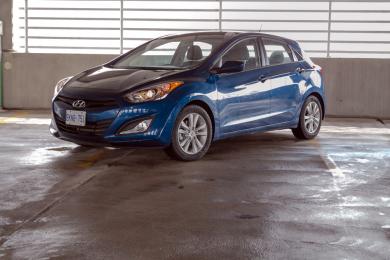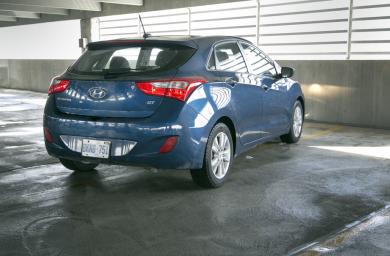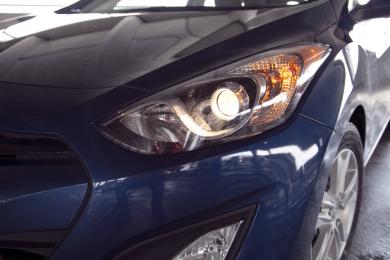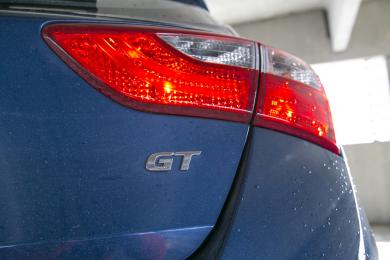Review and photos Jeff Wilson
We at Autos.ca are nothing if not a fair lot. Sure it may seem at times that certain brands keep coming up at or near the top of our comparison tests, but rest assured, they’re always hard-fought and well deserved victories, and every car gets the same fair shot at the title.
With that never ending quest for even handedness in mind, we immediately put in a request for a 2014 Hyundai Elantra GT after the 2013 model faired a disappointingly low 8th place in our recent 11-car compact segment comparison test. We did so based on the knowledge of the new car being fitted with an updated drive train. Only a year earlier, Hyundai’s compact hatchback claimed the top spot in another comparison test. All this is to say nothing of Hyundai’s consistent podium finishes in most Autos.ca comparison tests. So what gives with that 2013 model?
For one, the Elantra GT struck our reviewers as being a decent car, but somewhat lacking in the features and amenities department – a strange twist for a brand typically known to load up its cars with amenities for very little cost. More importantly, Hyundai’s compact hatchback trailed the best of the bunch by a fair margin in the driving dynamics.
  2014 Hyundai Elantra GT. Click image to enlarge |
The folks at Hyundai have not been ones to rest on their laurels of late, and likely do not take kindly to one of their most popular machines falling behind the ever-improving competition. Which is why we probably should not be surprised to see Hyundai not simply make a few mid-cycle changes to the Elantra GT, but rather toss the whole engine / transmission set in the bin and replace it with a new 2L inline-4 cylinder unit that bumps torque by 23 lb-ft to 154 and horsepower by 25 to 173 over the old 1.8L mill.
This new engine is a noticeable and greatly appreciated improvement over the old one and helps to keep the Elantra GT moving spritely through traffic. But, if you have had a taste of some of the Elantra GT’s competitors fitted with small displacement turbocharged four-bangers (Chevy Cruise, Dodge Dart GT and VW Jetta 1.8T), you may question the Korean car’s torque figure. The torques are all there, they all just show up to the party after 4,500 rpm, so you’ll need to rev the “Nu” engine (Hyundai’s internal name for it) to get the most out of it.
  2014 Hyundai Elantra GT. Click image to enlarge |
Although Hyundai claims the best power-to-weight ratio in the segment, the power delivery gives the impression that the Elantra GT is not as quick in day-to-day driving as some of those boosted competitors – a reminder that numbers on a page do not always tell the whole story.
It would be reasonable to assume the larger and more powerful engine would be at the expense of reduced fuel efficiency, but impressively, this is not the case. Rated at 8.5 L/100 km (City) and 5.8 L/100 km (Highway) for the six-speed manual, the Elantra GT with the 2L engine is actually fractionally better than last year’s 1.8L.
It has been said that the way to a man’s heart is through his stomach, but to win this writer’s affections, simply provide a fun car with a good manual transmission set up. Hyundai offered up a test car with just such a gearbox and happily it does a fine job of contributing to the driving woo. The gears are well spaced and enable the driver to keep the car in the lively part of its power band. Clutch action is light and shift throws are reasonably short though there is some vagueness to the gate versus, say a Honda ‘box.
The Elantra’s stick-shift set up does not offer a rollback mitigation feature found on several other cars. Given the disinterest in most drivers learning or maintaining the skill of three-pedal driving, little features like this can go a long way to help driving purists pass along the craft to new drivers who might be reticent about becoming tripedalists.
One aspect of the Elantra GT’s driving dynamics that Hyundai has not improved upon (though should have) is the handling. Hyundai fits their Driver Selectable Steering Model (DSSM) to all Elantra GTs that enables the driver to choose between a Normal steering setting, Comfort and Sport.
In Normal mode, the steering feels vague and absent of any direct mechanical connection to the road. In Comfort the steering remains vague but also offers up a bit of inactivity and numbness on-centre coupled with virtually no physical exertion required to rotate the wheel (a benefit if your arms have atrophied or you’re a Tyrannosaurs Rex).
   2014 Hyundai Elantra GT. Click image to enlarge |
Sport setting offers the driver slightly more upper body exercise without the advantage of much improvement in feel or contact patch information.
In the interest of full disclosure and in complete fairness to the Elantra, our test car was fitted with aggressive snow tires that offered minimal dry-road traction and squirmed more than a pocket full of mealworms. These tires certainly contributed to the aloof nature of the Elantra’s steering.
Our test car was a mid-trim level GLS model. At this price point ($21,699) buyers will enjoy a 6-speaker stereo (featuring satellite radio and iPod connectivity) with decent sound; heated cloth front seats (driver’s with power function) and the usual host of comprehensive passive safety features found across the segment. What you won’t find is automatic climate control, leather seating or larger 17” wheels and tires – all available in the costlier SE model.
You also won’t get the slick touchscreen infotainment unit found in the new Mazda3 Sport – a direct competitor to the Elantra GT, and a comparably equipped GS model with ”Convenience Package” rings in several hundred bucks less than the Hyundai.
The Mazda gives up about 20 horsepower and the fantastic Panorama roof found in the Elantra. The latter essentially turns the entire top of the roof – front-to-rear – into two giant glass panels providing some welcome sunlight during this long, dreary winter we are having.

























Although the interior materials and finishes are generally of high quality and feel reasonably rich in this class of car, the overall interior design initially seems simple and dated compared to some of the impressive newcomers from Mazda, Toyota and Dodge. With more seat time a driver will come to appreciate the careful consideration paid to the layout of the controls. Buttons and switches are all large (operating them with winter gloves proved completely doable) and well marked, and their placement sensible. Rotary knobs are provided for HVAC fan and temperature control as well as volume and tuning of the radio.
While operation of the blue backlit LCD audio system seems archaic versus a contemporary touchscreen system, its operation is fairly logical and once set, provides decent sound. Anyone who parks their Elantra GT in higher crime areas will wish the iPod and Auxiliary plug-in points would keep these accessories contained within an enclosure rather than exposed to prying eyes in an open cubby.
Both passenger space and cargo capacity are competitive against the best of class without actually being the largest – or smallest – in any category. Subjectively we found headroom decent front and rear even with the Panorama roof and legroom front and rear is typical of the class which is to say reasonable for most people in short jaunts, or good for young families.
In our aforementioned 11 compact car comparison test, Peter Bleakney said “The new for 2014 2.0L can’t come fast enough.” Now that it’s here, is Hyundai’s Elantra GT a stronger contender within the segment? Would it have placed higher than 8th in our group? In its more affordable GLS trim and with this vastly improved engine, it surely would have eked out a few more places, but drivers who prefer a more dynamic driving experience or sexier styling are likely to choose the newer competitors in this segment.
Pricing: 2014 Hyundai Elantra GT GLS 6 spd manual
Base Price (L trim level): $18,349
Base Price (GLS trim level): $21,699
Options: none.
Destination: $1,650
A/C Tax: $100
Price as tested: $23,499
Competitors:
Chevrolet Cruze
Dodge Dart
Ford Focus
Honda Civic
Kia Forte
Mazda3 Sport
Nissan Sentra
Subaru Impreza
Toyota Corolla
Volkswagen Jetta
Crash test results
National Highway Traffic Safety Administration (NHTSA)
Insurance Institute for Highway Safety (IIHS)











